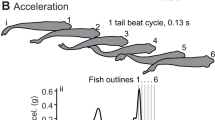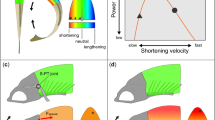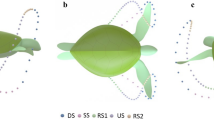Abstract
IN several respects the skipjack (Katsuwonus pelamis) can be considered the most highly specialized of the scombroid fishes: in this species, the swimbladder has been lost, the branchial musculature is extremely reduced, and the deep red muscle, found only in the tunas, assumes the largest proportion of the trunk musculature of any of the species investigated by Kafuku1 in his comparative study of the distribution of red muscle. Constant forward motion is thus required, not only to give hydrodynamic lift but also to provide a flow of water over the gill surfaces; it seems reasonable to suppose that the large amount of deep red muscle is in some way associated with these requirements. Braekkan2, on the basis of a primarily biochemical investigation, has concluded that this deep red muscle functions as a store of energy for the adjacent region of white rather than as a contractile tissue in its own right. Recent work on the red muscles of other teleosts3,4 has shown that they are fully contractile and have neuromuscular properties similar to the slow fibres of terrestrial vertebrates. These muscles are found in situations in which prolonged activity is required. By analogy with other fish, it might therefore be thought that the constant “basal swimming” of the scombroids would be a result of red muscle contraction. There remained the possibility that in the highly specialized scombroids the deep red muscle might indeed be found to perform a maintenance function; Braekkan2 has stated that … “The anatomical situation of the red muscle prevents its taking part in the main muscular work”.
This is a preview of subscription content, access via your institution
Access options
Subscribe to this journal
Receive 51 print issues and online access
$199.00 per year
only $3.90 per issue
Buy this article
- Purchase on Springer Link
- Instant access to full article PDF
Prices may be subject to local taxes which are calculated during checkout
Similar content being viewed by others
References
Kafuku, T., Jap. J. Icthy., 1, 89 (1950).
Braekkan, O. R., Nature, 178, 747 (1956).
Tekeuchi, A., J. Cell. Comp. Physiol., 54, 211 (1959).
Barets, A., Arch. Anat. Micros. Morphol. Exp., 50, 91 (1961).
Author information
Authors and Affiliations
Rights and permissions
About this article
Cite this article
RAYNER, M., KEENAN, M. Role of Red and White Muscles in the Swimming of the Skipjack Tuna. Nature 214, 392–393 (1967). https://doi.org/10.1038/214392a0
Issue Date:
DOI: https://doi.org/10.1038/214392a0
This article is cited by
-
The predominant stride-frequency for routine swimming in catsharks (Scyliorhinus canicula) generates high power at high efficiency in the red musculature
Journal of Muscle Research and Cell Motility (2023)
-
Scaling with body mass of mitochondrial respiration from the white muscle of three phylogenetically, morphologically and behaviorally disparate teleost fishes
Journal of Comparative Physiology B (2010)
-
Endothermy in fishes: a phylogenetic analysis of constraints, predispositions, and selection pressures
Environmental Biology of Fishes (1994)
-
A comparative study on certain biochemical aspects of red and white myotomal muscles of the black skipjack tuna,Euthynnus affinis Cantor
Proceedings: Animal Sciences (1982)
-
Endurance exercise training in the fast and slow muscles of a teleost fish (Pollachius virens)
Journal of Comparative Physiology ? B (1980)
Comments
By submitting a comment you agree to abide by our Terms and Community Guidelines. If you find something abusive or that does not comply with our terms or guidelines please flag it as inappropriate.



